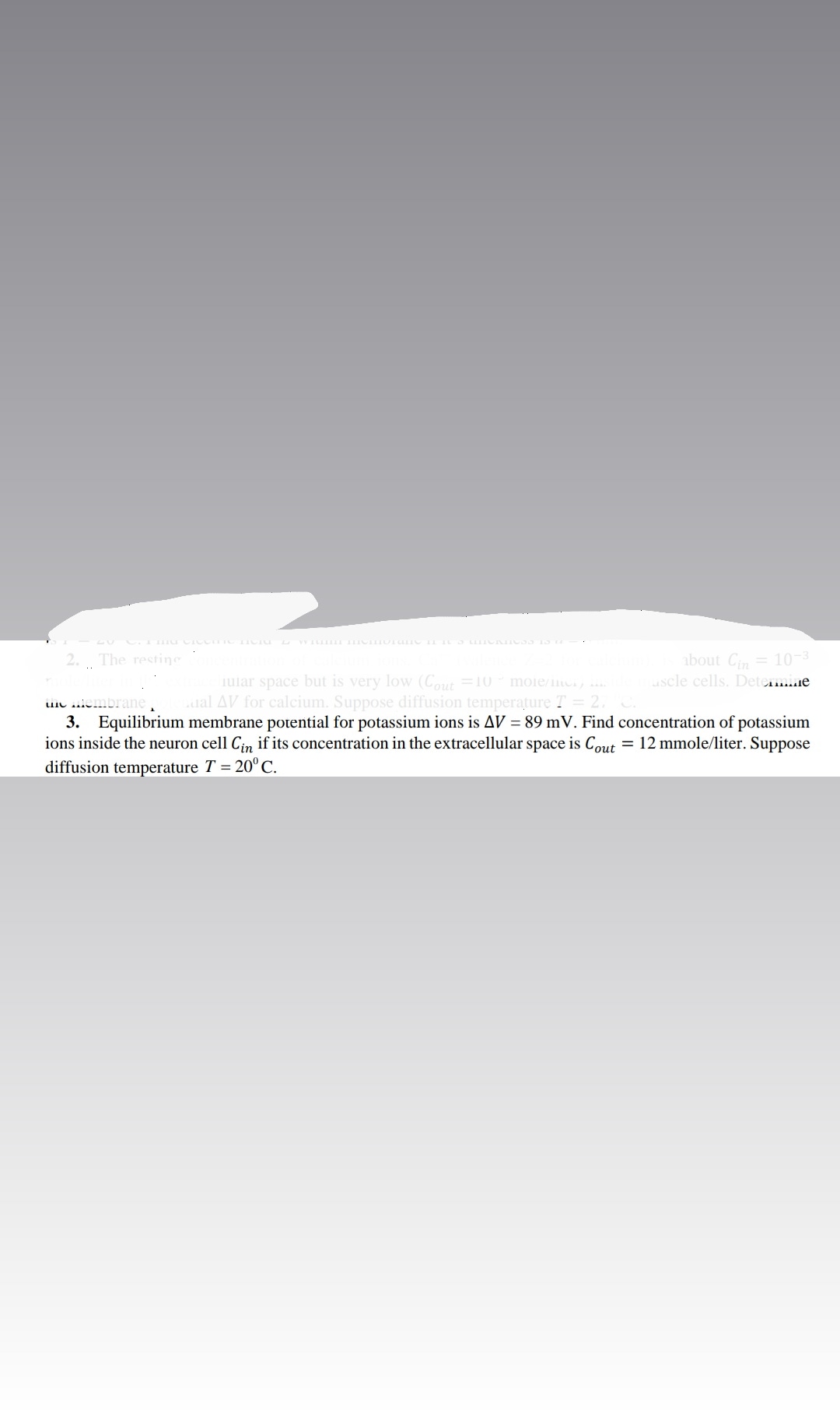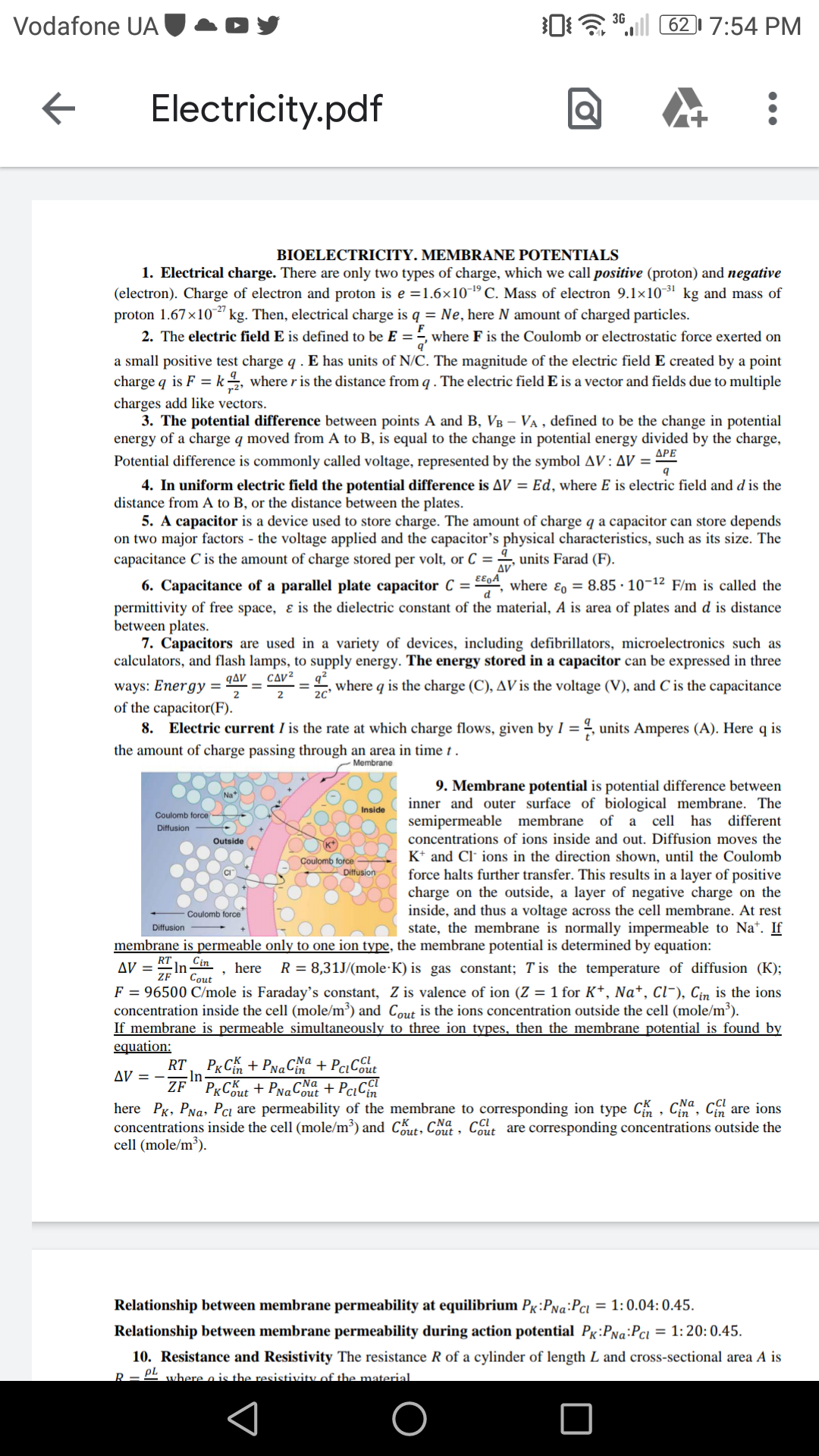
College Physics
11th Edition
ISBN: 9781305952300
Author: Raymond A. Serway, Chris Vuille
Publisher: Cengage Learning
expand_more
expand_more
format_list_bulleted
Question

Transcribed Image Text:about Ci= 10-3
uscle cells. Detemine
2. The restine
iular space but is very low (Cout =10
ual AV for calcium. Suppose diffusion temperature T
moie/ii .
uiu iembrane
3. Equilibrium membrane potential for potassium ions is AV = 89 mV. Find concentration of potassium
ions inside the neuron cell Cin if its concentration in the extracellular space is Cout = 12 mmole/liter. Suppose
diffusion temperature T = 20°C.

Transcribed Image Text:0a ".l 6217:54 PM
3G
Vodafone UA
Electricity.pdf
BIOELECTRICITY. MEMBRANE POTENTIALS
1. Electrical charge. There are only two types of charge, which we call positive (proton) and negative
(electron). Charge of electron and proton is e =1.6×10-1º C. Mass of electron 9.1×10-3' kg and mass of
proton 1.67x10" kg. Then, electrical charge is q = Ne, here N amount of charged particles.
2. The electric field E is defined to be E = =, where F is the Coulomb or electrostatic force exerted on
a small positive test charge q . E has units of N/C. The magnitude of the electric field E created by a point
charge q is F = k, where r is the distance from q . The electric field E is a vector and fields due to multiple
charges add like vectors.
3. The potential difference between points A and B, VB – VA , defined to be the change in potential
energy of a charge q moved from A to B, is equal to the change in potential energy divided by the charge,
ДРЕ
Potential difference is commonly called voltage, represented by the symbol AV: AV =
4. In uniform electric field the potential difference is AV = Ed, where E is electric field and d is the
distance from A to B, or the distance between the plates.
5. A capacitor is a device used to store charge. The amount of charge q a capacitor can store depends
on two major factors - the voltage applied and the capacitor's physical characteristics, such as its size. The
capacitance C is the amount of charge stored per volt, or C =
units Farad (F).
EE9A
6. Capacitance of a parallel plate capacitor C = 4, where ɛ, = 8.85 · 10-12 F/m is called the
permittivity of free space, & is the dielectric constant of the material, A is area of plates and d is distance
between plates.
7. Capacitors are used in a variety of devices, including defibrillators, microelectronics such as
calculators, and flash lamps, to supply energy. The energy stored in a capacitor can be expressed in three
CΔν2
qΔν
ways: Energy =
of the capacitor(F).
8. Electric current I is the rate at which charge flows, given by I = , units Amperes (A). Here q is
, where q is the charge (C), AV is the voltage (V), and C is the capacitance
the amount of charge passing through an area in time t .
Membrane
9. Membrane potential is potential difference between
inner and outer surface of biological membrane. The
semipermeable membrane of a cell has different
Na*
Inside
Coulomb force
Diffusion
concentrations of ions inside and out. Diffusion moves the
Outside
K* and Cl- ions in the direction shown, until the Coulomb
force halts further transfer. This results in a layer of positive
charge on the outside, a layer of negative charge on the
inside, and thus a voltage across the cell membrane. At rest
state, the membrane is normally impermeable to Na*. If
Coulomb force
Diffusion
Coulomb force
Diffusion
membrane is permeable only to one ion type, the membrane potential is determined by equation:
RT
In-
Cin
AV =
here
R = 8,31J/(mole·K) is gas constant; T is the temperature of diffusion (K);
Cout
F = 96500 C/mole is Faraday's constant, Z is valence of ion (Z = 1 for K+, Na*, Cl¯), Cin is the ions
concentration inside the cell (mole/m³) and Cout is the ions concentration outside the cell (mole/m³).
If membrane is permeable_ simultaneously to three ion types, then the membrane potential is found by
equation:
RT, P«C% + PNaCa + PciC6ut
-In-
AV = - ZF"PxCK + PNaCout + PciCin
here Px, PNa, Pcı are permeability of the membrane to corresponding ion type C , Cia, c
concentrations inside the cell (mole/m³) and Cout, Cout, Cout are corresponding concentrations outside the
cell (mole/m³).
, Cin are ions
Relationship between membrane permeability at equilibrium Px:PNa:Pci = 1: 0.04: 0.45.
Relationship between membrane permeability during action potential Pg:PNa:Pci
= 1:20: 0.45.
10. Resistance and Resistivity The resistance R of a cylinder of length L and cross-sectional area A is
PL where o is the resistivity of the material.
Expert Solution
This question has been solved!
Explore an expertly crafted, step-by-step solution for a thorough understanding of key concepts.
Step by stepSolved in 2 steps with 2 images

Knowledge Booster
Similar questions
- Water vapor at a pressure 0f 2X10 N/m2 0nd a dempirature of as0°c is 0.32 x106 N/m2.following expanded to a yoessune of ec.For the low P.V1.25 this expanston determine: a. Pinal vapor condnion b. Syecipie haat transpan c. Changis in tntroyy SIDUarrow_forwardin ur own words Describe what specifically happens to neurons when the brain is suddenly jolted.arrow_forwardW NWP Assessment Builder Ul App x wwNWP Assessment Player Ul Appli X b Home | bartleby education.wiley.com/was/ui/v2/assessment-player/index.html?launchid=03be40d5-94c7-456c-a175-078cbc7944fc#/question/23 ← → C Help Centre a myMapúa: Welcome Microsoft Office Ho... Courses Microsoft Teams - L...Mail-ALLYSON VIV... ParentPortal | Mapu... Current Attempt in Progress ● WP R(smaller) = i R(larger) = i Save for Later 34°C Sunny - = Units Units Q Search x + Two resistors have resistances R(smaller) and R(larger), where R(smaller) < R(larger). When the resistors are connected in series to a 12.0-V battery, the current from the battery is 1.33 A. When the resistors are connected in parallel to the battery, the total current from the battery is 9.04 A. Determine the two resistances. V ParentPortal | Mapu... MathWorks - Make.. ps Turning Point - Parti.... a 12 Explore GitHub ☆ * ENG US 0 X D ⠀ 33 Attempts: 0 of 3 used Submit Answer 2:27 pm 18/03/2023arrow_forward
- 3)arrow_forwardSupport Facilitators anc X di Join conversation e Quiz: C.A.R.E. Assessmex di Join conversation W Grades ttps://browardschools.instructure.com/courses/1117234/quizzes/7095833/take/quest... ating Ca. Powerpoint Body S... The graph below shows how pulse rate changes with exercise. EXERCISE and PULSE RATE 160 140 120 100 80 60 40 20 Times In Minutes Which of the following best explains how body systems worked together to create the results shown on the graph? O As the body uses its excretory system to eliminate wastes, the digestive system takes in more nutrients for growth and development. O As the body exercises using the musculoskeletal system, the circulatory system pumps more blood and oxygen throughout the body. O As the body breaks down food using the digestive system, the nervous system communicates to the musculoskeletal system to exercise the body so as to prevent weight gain. O As the body exercises using the musculoskeletal system the respiratory system takes in more Pulse…arrow_forward(a) Find the average time required for an oxygen moleculeto diffuse through a 0.200-mm-thick tear layer on the cornea.(b) How much time is required to diffuse 0.500 cm3 ofoxygen to the cornea if its surface area is 1.00 cm2 ?arrow_forward
arrow_back_ios
arrow_forward_ios
Recommended textbooks for you
 College PhysicsPhysicsISBN:9781305952300Author:Raymond A. Serway, Chris VuillePublisher:Cengage Learning
College PhysicsPhysicsISBN:9781305952300Author:Raymond A. Serway, Chris VuillePublisher:Cengage Learning University Physics (14th Edition)PhysicsISBN:9780133969290Author:Hugh D. Young, Roger A. FreedmanPublisher:PEARSON
University Physics (14th Edition)PhysicsISBN:9780133969290Author:Hugh D. Young, Roger A. FreedmanPublisher:PEARSON Introduction To Quantum MechanicsPhysicsISBN:9781107189638Author:Griffiths, David J., Schroeter, Darrell F.Publisher:Cambridge University Press
Introduction To Quantum MechanicsPhysicsISBN:9781107189638Author:Griffiths, David J., Schroeter, Darrell F.Publisher:Cambridge University Press Physics for Scientists and EngineersPhysicsISBN:9781337553278Author:Raymond A. Serway, John W. JewettPublisher:Cengage Learning
Physics for Scientists and EngineersPhysicsISBN:9781337553278Author:Raymond A. Serway, John W. JewettPublisher:Cengage Learning Lecture- Tutorials for Introductory AstronomyPhysicsISBN:9780321820464Author:Edward E. Prather, Tim P. Slater, Jeff P. Adams, Gina BrissendenPublisher:Addison-Wesley
Lecture- Tutorials for Introductory AstronomyPhysicsISBN:9780321820464Author:Edward E. Prather, Tim P. Slater, Jeff P. Adams, Gina BrissendenPublisher:Addison-Wesley College Physics: A Strategic Approach (4th Editio...PhysicsISBN:9780134609034Author:Randall D. Knight (Professor Emeritus), Brian Jones, Stuart FieldPublisher:PEARSON
College Physics: A Strategic Approach (4th Editio...PhysicsISBN:9780134609034Author:Randall D. Knight (Professor Emeritus), Brian Jones, Stuart FieldPublisher:PEARSON

College Physics
Physics
ISBN:9781305952300
Author:Raymond A. Serway, Chris Vuille
Publisher:Cengage Learning

University Physics (14th Edition)
Physics
ISBN:9780133969290
Author:Hugh D. Young, Roger A. Freedman
Publisher:PEARSON

Introduction To Quantum Mechanics
Physics
ISBN:9781107189638
Author:Griffiths, David J., Schroeter, Darrell F.
Publisher:Cambridge University Press

Physics for Scientists and Engineers
Physics
ISBN:9781337553278
Author:Raymond A. Serway, John W. Jewett
Publisher:Cengage Learning

Lecture- Tutorials for Introductory Astronomy
Physics
ISBN:9780321820464
Author:Edward E. Prather, Tim P. Slater, Jeff P. Adams, Gina Brissenden
Publisher:Addison-Wesley

College Physics: A Strategic Approach (4th Editio...
Physics
ISBN:9780134609034
Author:Randall D. Knight (Professor Emeritus), Brian Jones, Stuart Field
Publisher:PEARSON